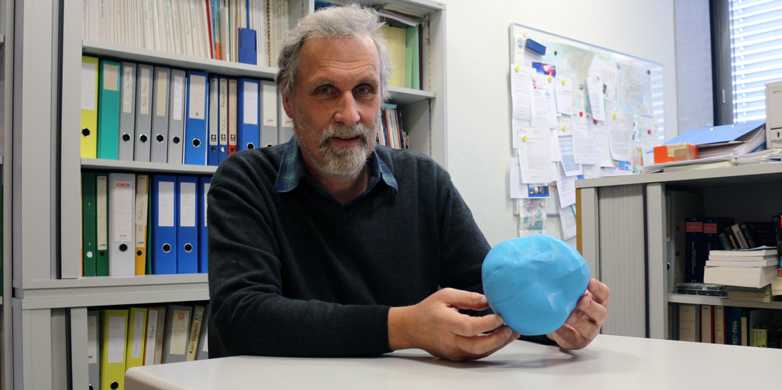A passion for predictions
For 35 years, Alain Geiger has been dedicating his efforts to measuring the Earth and its atmosphere at the Institute of Geodesy and Photogrammetry. He has discovered that Switzerland is gradually growing in height.
Alain Geiger has been interested in weather ever since he was young. As he sat in his sailing boat, gliding across the water, the sun, wind, clouds and rain were never very far away. “I was fascinated by the wind and often wondered about the connection between the wind and the boat as it sailed along,” said the 60-year-old professor. “It was the formulae behind these kinds of relationship that interested me the most.”
He found the answers he was looking for when he was studying physics at ETH Zurich, particularly in the field of geophysics. His goal was to come up with hypotheses and make forecasts as to how the weather would unfold. He had always been interested in geography too, but the main focus of geographical research at the time was on describing things like countries, mountains and bodies of water.
“There is nothing you can predict,” he says. “It’s all already there.” Working in that particular field was therefore not an option for him, as he is keen to point out: “I don’t feel that I’ve really understood something until I can anticipate it.”
Even today, 35 years after completing his degree studies, his attitude remains virtually unchanged. He still takes enthusiastic pleasure in investigating interrelationships – which he now does in his capacity as an adjunct professor at the Institute of Geodesy and Photogrammetry (IGP), where he develops methods and applications for measuring geodetic and geophysical correlations: “We measure things like how Switzerland is being ‘compressed’, for example, and where it is ‘growing taller’.”
A pioneer in GPS technology
The IGP is where Professor Geiger began his academic career, initially as an assistant. The late 1970s saw the emergence of satellite measurements and navigation, paving the way for the modern global positioning system – or GPS – that is now a feature of every mobile phone. Taking satellite measurements involves using satellites in space as reference points which transmit signals back down to Earth. This makes it possible to work out the coordinates of a particular location.
Geiger and his team were amongst the first to use the devices designed for this and to develop software for taking such measurements. To do this, Geiger conducted countless field trials and carried out numerous experimental measurements – not just in Switzerland, but in places like Africa, Greece and Venezuela too.
From weather forecasts to sailing
Professor Geiger’s current work focuses primarily on Switzerland. With the help of a GPS measurement system, he and his colleagues locate phenomena such as water vapour in the atmosphere. As Geiger explains, if you know what quantities of water vapour have accumulated in which areas, you can tell where humidity levels are particularly high: “That information can be incorporated into weather forecasts.”
Weather forecasts are likely to prove useful to him on a personal level in around four years’ time, if not sooner. That is when he is due to retire, at which point he is eager to devote more time to cultivating his saxophone skills and, in particular, his love of sailing. He is not yet sure where his boat will take him, but there is one thing he is certain about: “It will be quite a long voyage.”
Anniversaries
March 2015
35 years
Prof. Alain Geiger, Institute of Geodesy and Photogrammetry
Prof. Adrian Leuchtmann, Institute of Integrative Biology
Daniel Keller, Facility Management Infrastructure Division
Werner Schmidheiny, Institute of Polymers
Bruno Schnider, Process Planning and Projects
Prof. Peter Johann Walde, Department of Materials
30 years
Fritz Michel, Department of Chemistry and Applied Biosciences
25 years
Peter Heinrich Albrecht, Power Electronic Systems Laboratory
Heinz Buschor, Institute for Geotechnical Engineering
Oswald Leonz Greter, Mass Spectrometry Service in the Laboratory of Organic Chemistry
Dr Elmar Sales Heeb, IT Services Group, Department of Physics
Tamas Szabo, Facility Management Infrastructure Division
20 years
Gerhard Egli, Institute of Energy Technology
Dr Wolfgang Knecht, Chair of Neurosciences
Lone Schmidt, ETH-Bibliothek
Dr Michael Stauffacher, Institute for Environmental Decisions
Melanie Vetsch, Chemistry ǀ Biology ǀ Pharmacy Information Center
15 years
Dominic Dähler, Department of Biology
Donat Fulda, Swiss Geotechnical Commission
Fritz Graber, Facility Management Infrastructure Division
Andrea Merkel, ETH-Bibliothek
Bernhard Morath, Mechanical Workshop, Deparment of Physics
Heinz-André Huonker, Facility Management Infrastructure Division
Dr Karsten Wegner, Institute of Process Engineering
10 years
Muhammad Kassiem Jacobs, Department of Biology
Dr Jozef Adamcik, Institute of Food, Nutrition and Health
Benedict John Angst, Facility Management Infrastructure Division
Dr Hans-Joachim Böckenhauer, Chair of Information Technology and Education
Sandrine Anne Frederique Goethals, ITS User Services
Andreas Schneider, Laboratory of Physical Chemistry
Gürkan Sengün, IT Services Group, Department of Physics
Regula Grüniger Stössel, Chair of Organic Chemistry
Oliver Zgraggen, Facility Management Infrastructure Division
Dr Mikalai Zhyhadla, Laboratory for Solid State Physics
Retirements
Erich Werner Blattmann, Accounting Department
Maria Furrer, Institute of Environmental Engineering
Ursi Hoerner, Institute for Transport Planning and Systems
Rita Heigert, Power Systems Laboratory
Annamarie Jezler, Assistant to President
Bruno Kramer, Institute of Process Engineering
Urs Meile, Network Security Group
Ronald Peikert, Department of Computer Science
Deaths
Alexandra Ina Kleihues, Collegium Helveticum

